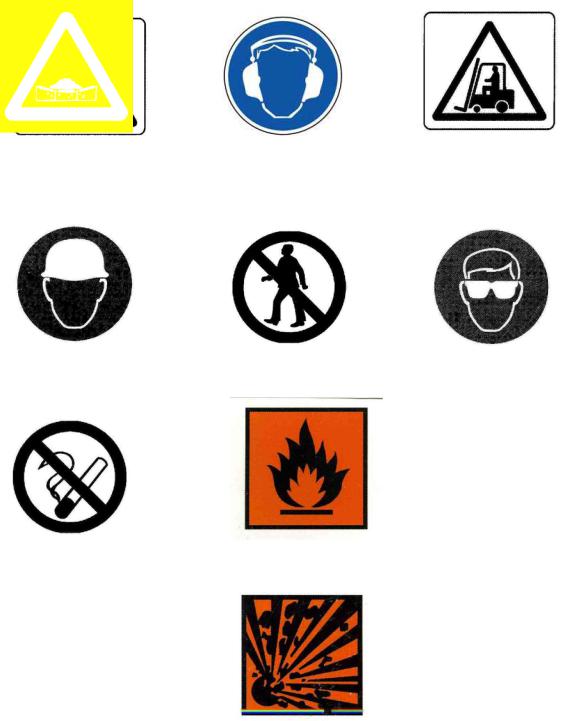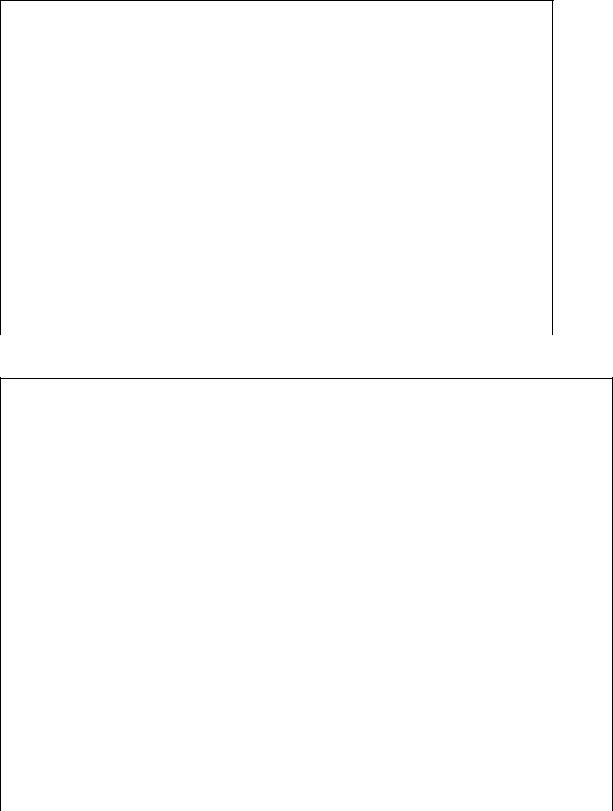
ENGLISH for Study and Work том 1
.pdf•Make a conclusion on the main elements of the genre of the text.
•Share the reading strategies you have used.
6.Read the instructions and warnings (1 – 12). Underline any new words and check their meaning in a dictionary. Then match the sentences with the signs (a – l) given below.
1. Risk of death here.
2. Be careful.
3. Beware of industrial vehicles/forklifts.
4. Beware of the material falling from conveyor belt.
5. Don’t smoke here.
6. Don’t walk here.
7. This material is flammable.
8. This material is corrosive.
9. This material is explosive.
10. Wear ear defenders.
11. Wear goggles to protect your eyes.
12. Wear a hard hat.
13. _________________________________________________________
14. _________________________________________________________
15. _________________________________________________________
16. _________________________________________________________
17. _________________________________________________________
140398

|
WARNING AND INSTRUCTION SIGNS |
|
a) |
b) |
c) |
d) |
e) |
f) |
g) |
h) |
i) |
|
|
j) |
|
k) |
l) |
|
7. Pair-work. Work in pairs. Write warning instruction(s) for your area of study and/or work. Design and draw warning sign(s) for each of the instruction.
Example: You must wear a miner’s helmet in a mine.
141390

8.Show your signs to another pair. Discover whether they can follow your instructions.
9.Complete the list of warnings and instructions with the instructions to the signs designed by your group.
 Grammar Reference: Modals, Imperatives.
Grammar Reference: Modals, Imperatives.
Follow-up:  Check Your Reading Fluency
Check Your Reading Fluency
10. You will be given not more than 5 minutes to read the text given below and answer the following comprehension questions:
•What is coal?
•How is coal often called? Why?
•When was coal first discovered?
•How was coal formed?
•Why is coal considered the most important fuel?
While reading you can choose a suitable strategy from the list given below:
Strategy A |
Strategy B |
Strategy C |
Strategy D |
|||
|
|
|
|
|
|
|
1. |
Read the text. |
1. |
Read the questions. |
1. |
Skim the text. |
1. Read the |
|
|
|
|
|
|
questions. |
|
|
|
|
|
|
|
2. |
Read the |
2. |
Read the text |
2. |
Read the |
2. Skim the text |
questions. |
carefully to find the |
questions. |
for the answers. |
|||
|
|
answers. |
|
|
|
|
|
|
|
|
|
|
|
3. |
Go back and |
3. |
Go back and check |
3. |
Scan the answers |
|
skim the |
the answers against the |
to the questions. |
|
|||
answers. |
questions. |
|
|
|
||
|
|
|
|
|
||
1420

COAL
Mining today is generally much safer, and has become highly mechanized work. Small crews with sophisticated machinery have replaced the hordes of men valued for their muscle and stamina.
Coal was one of humanity's earliest sources of heat and light. The Chinese were known to have dug it more than 3,000 years ago.
But coal's origins go back much further.
Coal is the remnant of vegetation that grew 400 million years ago in large swamps that no longer exist. The fossil fuel is often called "buried sunshine" because the trees and plants that formed coal captured the sun's energy through photosynthesis.
As layers of flora and trees accumulated, they formed a soggy dense material called peat. Over time, as the earth's crust shifted, deposits of sand, clay and other mineral matter buried the peat. Pressure squeezed water from the peat and the earth's heat forged chemical elements together that resulted in the black combustible mineral known as coal. It's estimated that about 3 feet to 7 feet of compacted plant matter were required to form 1 foot of bituminous coal.
Carbon is what gives coal most of its energy, and it's the reason that coal was the country's most important fuel.
11. Whole-group discussion. Share your experience with your groupmates by answering the following questions:
•How did you read the text?
•What strategy did you use?
•Why have you chosen it?
•Do you think if you had chosen the other strategy would you be a success and read faster?
•Which strategy is the fastest? Why?
12.You may try all the strategies with different texts of the same size and choose the most appropriate strategy to be within time limits.
1432

Unit 8 CHECK YOUR PROGRESS
Task 1. Look at notices (1-5). For each notice which sentence is correct? Circle only one letter (A, B or C).
1. DO NOT OPERATE THIS MACHINE WITHOUT SUPERVISION
A You are not allowed to operate this machine at any time.
B You must have someone with you who can use the machine. C You can only use this machine if you know how to operate it.
2. PLEASE NOTE:
THIS WEEK’S FACULTY MEETING WILL BE HELD AT 11. 45 A.M. INSTEAD OF 11. 15 A.M.
The Faculty meeting this week will take place at:
Aquarter to eleven
Bquarter past eleven
Cquarter to twelve
3.24/11/2006 Message for Natalie
Reminder – Call Kate Shevchenko 4.50 p.m
Natalie should phone Kate
Aon 24 March.
Bat ten to five.
Cat ten past four.
14432
4. Reproduction in whole or part of any photograph, text or illustration without written permission from the publisher is prohibited.
AThe publisher must write and allow you to use photos, texts and drawings from the magazine.
BYou must write to the publisher if you want to buy the photos, texts and drawings.
CYou can copy any photos, text or drawings from the magazine without asking.
5. IN THE EVENT OF FIRE ASSEMBLE IN THE YARD.
AIf there is an assembly problem, meet in the yard.
BIf there is a fire in the yard, gather together here.
CIf there is a fire, everyone should meet in the yard.
Task 2. Read the text that follows.
Do the following statements agree with the information given in the article? Choose ' A' for 'Yes' if the statement agrees with the information,
‘B' for 'No' if the statement contradicts information.
If there is not enough information to answer "Yes” or "No" choose ‘С’- ‘Not given'.
Circle the appropriate letters.
6.The eruption was caused by the boundary of two moving plates of the Earth.
7.There had been three major eruptions of Mount St. Helen.
8.Nothing was made to evacuate people from the region close to the mountain.
9.There was an earthquake in the region caused by the growth of the mountain.
10.Scientists were able to analyse the sequence of the events.
11.The Geological Survey started its activity in 1979.
1453
The Spectacular Eruption of Mountain St Helen
A |
The eruption in May 1980 of Mount St. |
bulged, and the summit rose by 500 feet. |
Helens, Washington State, astounded the world |
E Steps were taken to evacuate the population. |
|
with its violence. A gigantic explosion tore |
||
much of the volcano's summit to fragments; |
Most - campers, hikers, timber-cutters - left the |
|
the energy released was equal to that of 500 of |
slopes of the mountain. Eighty-four-year-old |
|
the nuclear bombs that destroyed Hiroshima in |
Harry Truman, a holiday lodge owner who had |
|
1945. |
lived there for more than 50 years, refused to |
|
В |
|
be evacuated, in spite of official and private |
The event occurred along the boundary of |
urging. Many members of the public, |
|
two of the moving plates that make up the |
including an entire class of school children, |
|
Earth's crust. They meet at the junction of the |
wrote to him, begging him to leave. He never |
|
North American continent and the Pacific |
did. |
|
Ocean. One edge of the continental North |
F On May 18, at 8.32 in the morning, Mount |
|
American plate over-rides the oceanic Juan de |
||
Fuca micro-plate, producing the volcanic |
St. Helens blew its top, literally. Suddenly, it |
|
Cascade range that includes Mounts Baker, |
was 1300 feet shorter than it had been before |
|
Rainier and Hood, and Lassen Peak as well as |
its growth had begun. Over half a cubic mile |
|
Mount St. Helens. |
of rock had disintegrated. At the same |
|
С Until Mount St. Helens began to stir, only |
moment, an earthquake with an intensity of 5 |
|
on the Richter scale was recorded. It triggered |
||
Mount Baker and Lassen Peak had shown |
an avalanche of snow and ice, mixed with hot |
|
signs of life during the 20th century. |
rock - the entire north face of the mountain had |
|
According to geological evidence found by the |
fallen away. A wave of scorching volcanic gas |
|
United States Geological Survey, there had |
and rock fragments shot horizontally from the |
|
been two major eruptions of Mount St. Helens |
volcano's riven flank, at an inescapable 200 |
|
in the recent (geologically speaking) past: |
miles per hour. As the sliding ice and snow |
|
around 1900 B.C, and about A.D.1500. Since |
melted, it touched off devastating torrents of |
|
the arrival of Europeans in the region, it had |
mud and debris, which destroyed all life in |
|
experienced a single period of spasmodic |
their path. Pulverised rock climbed as a dust |
|
activity, between 1831 and 1857. Then, for |
cloud into the atmosphere. Finally, viscous |
|
more than a century. Mount St. Helens lay |
lava, accompanied by burning clouds of ash |
|
dormant. |
and gas, welled out of the volcano's new |
|
D By 1979, the Geological Survey, alerted by |
crater, and from lesser vents and cracks in its |
|
flanks. |
||
signs of renewed activity, had been monitoring |
G Afterwards, scientists were able to analyse |
|
the volcano for 18 months. It warned the local |
||
population against being deceived by the |
the sequence of events. First, magma - molten |
|
mountain's outward calm, and forecast that an |
rock - at temperatures above 2000°F had |
|
eruption would take place before the end of the |
surged into the volcano from the Earth's |
|
century. The inhabitants of the area did not |
mantle. The build-up was accompanied by an |
|
have to wait that long. On March 27, 1980, a |
accumulation of gas, which increased as the |
|
few clouds of smoke formed above the |
mass of magma grew. It was the pressure |
|
summit, and slight tremors were felt. On the |
inside the mountain that made it swell. Next, |
|
28th, larger and darker clouds, consisting of |
the rise in gas pressure caused a violent |
|
gas and ashes, emerged and climbed as high as |
decompression, which ejected the shattered |
|
20,000 feet. In April a slight lull ensued, but |
summit like a cork from a shaken soda bottle. |
|
the volcanologists remained pessimistic. Then, |
With the summit gone, the molten rock within |
|
in early May, the northern flank of the |
was released in a jet of gas and fragmented |
|
mountain |
magma, and lava welled from the crater. |
|
|
|
|
1465

H The effects of the Mount St. Helens eruption were catastrophic. Study of atmospheric particles formed as a result of explosion showed that droplets of sulphuric acid, acting as a screen between the Sun and the Earth’s surface, caused a distinct drop in temperature. Almost all the trees of the surrounding forest were flattered. Ash and mud spread over 250 square miles of country. All the towns and settlements in the area were smothered in an even coating of ash. It has been calculated that the quantity of dust ejected by Mount St. Helen – a quarter of a cubic mile
– was negligible in comparison with that thrown by the earlier eruptions.
Task 3. Complete the table below using the information from the text above.
Item |
Equivalent to |
|
|
Example |
Answer |
The energy released by the |
500 nuclear bombs |
explosion of Mount St. Helens |
|
|
|
The area of land covered in mud or |
12 |
ash |
|
|
|
The quantity of dust ejected |
13 |
|
|
Magma molten rocks were at |
14 |
temperatures |
|
|
|
The intensity of an earthquake was |
15 |
recorded on the Richter scale |
|
|
|
Choose the appropriate letter A – D and underline the whole statement.
14765
16. According to the text the eruption of Mount St. Helens and other volcanoes has influenced our climate by
Aincreasing the amount of rainfall.
Bheating the atmosphere.
Ccooling the air temperature.
Dcausing atmospheric storms.
17. By 1979 the volcano had been monitored
Afor 18 years.
Bfor 18 days.
Cfor 18 weeks.
Dfor 18 months.
Task 4. Read the memo and catalogue list below.
Complete the order form on the next page.
Write a word or phrase (in CAPITAL LETTERS) or a number on lines 18 – 22.
Memorandum
To Lucy Scrivener
From Bill Hammer
Lucy,
Can you please order some extra stationery for the reps' conference next week? Have a look at the Pens and More catalogue - they seem to be the best. We need enough for 10 reps. I suggest you get some A4 notepads, ballpoint pens, and ring binder files - one for each of the reps. Can you please also order 6 black marker pens and 50 OHP transparencies for me?
Thanks.
14876

Pens and More
Catalogue
Stationery supplies
Code |
Item |
Unit value £ |
|
|
|
ST 2367 |
A4 notepad - lined |
2.75 |
ST 2589 |
A5 Memo pad |
2.50 |
ST 0256 |
Ring binder file |
2.25 |
ST0148 |
Plastic folders - pack of 50 |
3.50 |
ST 0524 |
Plastic document folder |
2.60 |
ST5217 |
Roller ball pens - pack of 6 black |
3.99 |
ST 5796 |
Ballpoint pens - pack of 10 blue |
0.99 |
ST 5876 |
Board marker pens - pack of 6 black |
3.25 |
ST 5899 |
Pencils-pack of 10 HB |
0.36 |
ST1764 |
OHP transparencies - pack of 50 |
6.99 |
ST 1551 |
OHP pens - pack of 6 |
3.49 |
|
|
|
Office Supplies Order Form
Please fill in the order code, item description, quantity and unit value ONLY. Total amounts and the Grand Total will be completed by the Accounts Department.
Order |
Item description |
|
|
Quantity |
|
Unit value £ |
Total |
code |
|
|
|
|
|
|
amount £ |
ST 2367 |
(18).......................... |
|
|
10 |
|
2.75 |
|
|
|
|
|
|
|
|
|
ST 5796 |
BALLPOINT PENS - |
|
|
1 |
|
(19).......... |
|
|
PACK OF 10 BLUE |
|
|
|
|
|
|
(20) .......... |
RING BINDER FILE |
|
|
10 |
|
2.25 |
|
|
|
|
|
|
|
|
|
ST 5876 |
BOARD MARKER |
|
|
(21) ......... |
|
3.25 |
|
|
PENS -PACK OF 6 |
|
|
|
|
|
|
|
|
|
|
|
|
|
|
ST 1764 |
(22) .... :.................... |
- |
|
1 |
|
6.99 |
|
|
PACK OF 50 |
|
|
|
|
|
|
|
|
|
|
GRAND TOTAL |
|
|
|
|
|
|
|
|
|
|
|
Task 5. Read the article below. Choose the correct word to fill each gap from A, B, C on the next page. For each question (23-35), mark one letter (A, B, C). You may fill in the gaps with the appropriate word against the letter.
14987
